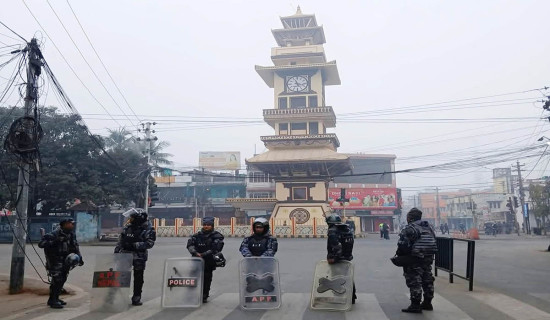- Wednesday, 7 January 2026
Translate Republican Ideals Into Reality
Nepal celebrated the 17th Republic Day on Jestha 15, 2081 B.S. Although the country had never been colonised, it has witnessed a series of revolts against its own rulers. People fought against the Ranas and the Shah dynasty tooth and nail before establishing the federal democratic republic. Now, as we mark the 17th year of republic, a relentless battle for power persists within political parties and coalition governments. Instead of institutionalising the democratic process, unnatural alliances and ideological deviation have become the norm. In a democratic system, dissent is crucial, but it should aim to protect citizens' rights and advance the country's progress, not cater to personal and petty desire of political parties and their leaders to retain power.
Nepal’s giant neighbour, India, has often been viewed as a beacon of an ideal republic with the inspiring Gandhian movement. However, examining the current state of federal republic systems in both Nepal and India, it is revealed that merely having a democratic system does not ensure citizens receive basic necessities for a dignified life. In India, the BJP-led government has harassed the people for merely speaking against its policies, and attacks on religious and ethnic minorities raise questions about what is happening in one of the world's largest democracies. When travelling around India during December 2023 and January 2024, it could be sensed that the BJP-led coalition would return to make a third term government without fail. It was also worrying why the media and the people were not raising their voices like they used to in the past.
Instability
Similarly, the continuous breaking and forming of coalition governments in Nepal have led to instability, worsening the lives of the underprivileged and is raising questions as to how has the federal republic process been taken forward here. The year 1768 marks the beginning of modern Nepal. Although the Shah dynasty ruled as a monarchy, government positions, including the prime minister, were hereditary, and the monarch had no real power. Dissatisfaction with Rana rule led the Nepali people to support the Shah dynasty in ousting them in 1951, ending the Rana Oligarchy. After 1951, Nepal was a constitutional monarchy until 1960, when King Mahendra suspended the constitution, assumed absolute power, and established the Panchayat system. Although the Panchayat system was democratic in theory, king Mahendra's autocratic regime turned it into an autocratic feudal system.
During India's independence movement against the British, Nepalis were revolting against the Ranas and the Shahs. Also, most of the Nepali leaders used to take refuse in India to escape the wrath of the royalties. A strong coalition between the Indian Congress and Nepali Congress together with the Indian and Nepali left parties were formed then. In 1990, the Nepali Congress and left-aligned political parties jointly staged a people’s movement, reinstating the constitutional monarchy. However, the leaders who protested against the royal regimes struggled to govern effectively, leading to frequent government changes and economic decline. As poverty increased, the CPN-Maoist started an underground civil movement, engaging in a bloody conflict with the government.
Eventually, a peace agreement allowed Maoist leaders to join the government, ending the civil unrest. In 2008, the monarchy was abolished, establishing the federal democratic republic of Nepal. It is a fact that the new constitution, promulgated in 2015, has several exemplary provisions to set up a true democratic process and enable the citizens to progress in life. In spite of that, it is a juxtaposition that, regardless of their background, some leaders revert to creating dynasties around them, seeking absolute power. As soon as Nepal became a republic, the constitution adopted gender and social inclusion policies that has facilitated in reflecting diverse genders and ethnicities in top positions, including the President, Vice President, and Speaker of the House.
Women and individuals from various ethnicities and regions have attained these positions. Additionally, the inclusion requirement in electoral systems has ensured representation from women, Dalits, and different ethnic communities in all top governing positions from wards to municipalities. Unfortunately, political parties and their leaders exploit loopholes to serve personal agendas, often sidelining gender balance in coalition formations. Simply having a system is not enough; internalising the philosophies of a federal republic by both leaders and citizens is essential. Utilising the loopholes, although diversity in ethnicity is reflected in the presidential and vice-presidential positions, gender diversity is lacking this time.
False hopes
The disappointment of the assessment of the election outcome in India during the last month of 2023 and beginning of 2024 has started changing now. When citizens are suffocated by atrocities, they will revolt. Indian citizens have proven this once more. It is now being evident in the 2024 elections in India, that people feel the Narendra Modi-led coalition have given false hopes which are being seen through. Especially, the possibility of changing the constitution to give priority to Hindu religion has not been digested by the citizens of a secular country.
Now, voices are being raised continuously all over the country against the functioning of the BJP-led government and the leadership of Modi. As Nepal celebrated the 17th Republic Day, leaders, who championed the transition from absolute monarchy to a Federal Republic, are reminded daily that they should work hard to promote good governance. They should embrace the ideals and vision of the constitution, ensuring citizens access to all their entitlements for a dignified life.
(Sharma is a senior journalist and women's rights advocate. namrata1964@yahoo.com. Twitter handle: @NamrataSharmaP)

















